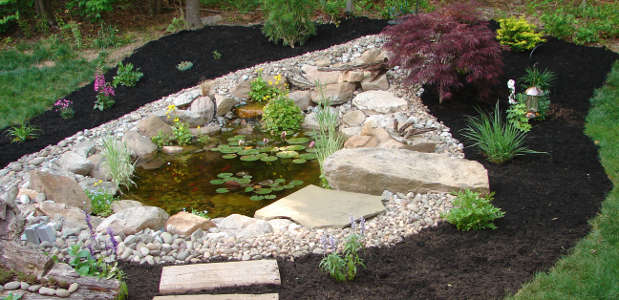
Few home improvement activities provide as much direct and natural rewards as building and maintaining a home garden. Still, it’s difficult to know where to begin or, if you like to continually change your garden design, how to choose your next garden theme. The Japanese garden is only one of many popular home gardening styles. It offers unique possibilities and challenges that appeal to many home gardeners. Here’s a brief introduction to both the underlying concepts and practices associated with the Japanese garden.
Japanese Garden Design
Japanese gardens are designed with two key concepts: naturalism and symbolism. Naturalism can be a tricky concept to understand in this context – what garden doesn’t feature nature, after all? What distinguishes the naturalism of an authentic Japanese garden is that every design element must be able to be produced by Mother Nature. In other words, ponds shouldn’t be lined with rocks that are laid in straight lines or ninety degree angles. Still, thoughtful design is an integral part. It’s not as though you take a handful of seeds and rocks and throw them up into the air to emulate some kind of organic randomness. Along with no geometric lines, use a wide variety of rock types and sizes. You can also use waterfalls, but not fountains.
Symbolism in a Japanese garden is less tricky to understand, if trickier to create. The symbolism attempts to create a grand landscape to a smaller scale: ponds represent lakes, streams represent rivers, rocks represent mountains, etc. One great idea for your Japanese garden is to try to recreate an actual landscape. You may have seen a breathtaking landscape during a vacation or honeymoon, and instead of a framed picture you can pay homage to that trip by imitating that landscape in your backyard.
Elements of a Japanese Garden
Rocks, sand and water are nearly mandatory for an authentic Japanese garden should be invested in. Again, vary rock selections and formations. A few larger rocks or boulders are a great way of creating “garden bones” that still fit the naturalistic mold. Some oriental gardeners include ornamental stone statues, but avoiding gazebos, pergolas, or other man made structures.
Ready to start your Japanese Garden Install?
Find ProsThere are few restrictions as to what plants you can include, but Japanese gardens are traditionally meant to be enjoyed year round, so including at least a few evergreens is a good idea. Japanese maples, bamboo, and reeds for the pond are only popular choices. Moss is great alternative to replace grass. One of the biggest and only mistakes you can make with plants is to use too many. You should be able to easily navigate and wander through a Japanese garden.
Your Own Home Garden
Of course, when designing your own home garden, there are no rules that can’t be broken. It’s a good idea to start with a particular theme or garden tradition, but few home gardens and home gardeners find strict adherence to these traditions allows them the freedom and relaxation of home gardening. Professional gardeners, however, can design a home garden and/or give you tips about how a Japanese garden can be adapted to your local climate and flora.
 Raising Chickens at Home
Raising Chickens at Home  Spring Garden Flower Tips and Suggestions
Spring Garden Flower Tips and Suggestions  Plan Ahead for a Better Yard
Plan Ahead for a Better Yard  Mature Tree Care and Tree Removal
Mature Tree Care and Tree Removal  Landscape Your Yard with Raised Bed Gardening
Landscape Your Yard with Raised Bed Gardening 

Are You Familiar With This Topic? Share Your Experience.